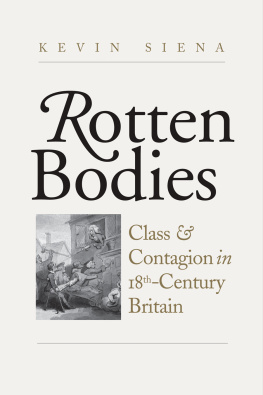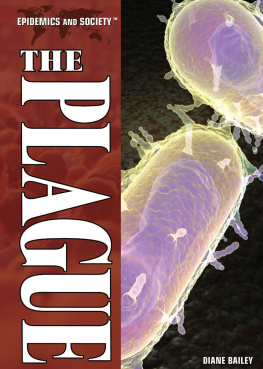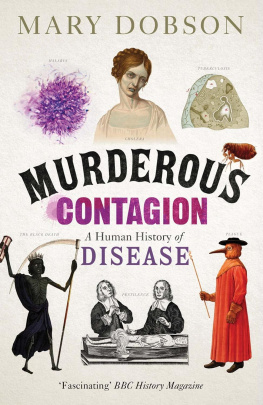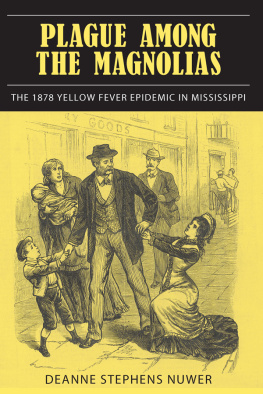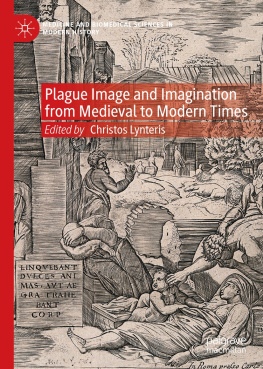Rotten Bodies

Published with assistance from the foundation established in memory of James Wesley Cooper of the Class of 1865, Yale College.
Published with assistance from the Annie Burr Lewis Fund.
Copyright 2019 by Kevin Siena.
All rights reserved.
This book may not be reproduced, in whole or in part, including illustrations, in any form (beyond that copying permitted by Sections 107 and 108 of the U.S. Copyright Law and except by reviewers for the public press), without written permission from the publishers.
Yale University Press books may be purchased in quantity for educational, business, or promotional use. For information, please e-mail (U.K. office).
Set in Fournier MT type by IDS Infotech Ltd.
Printed in the United States of America.
Library of Congress Control Number: 2018940908
ISBN 978-0-300-23352-0 (hardcover : alk. paper)
A catalogue record for this book is available from the British Library.
This paper meets the requirements of ANSI/NISO Z39.48-1992 (Permanence of Paper).
10 9 8 7 6 5 4 3 2 1
For Kate
Contents
Acknowledgments
I have incurred many debts while writing this book. Indeed, it has taken so long to complete that I am certain to forget some of the many kind people who took the time to share their expertise, alert me to sources, correct grievous errors, read drafts, or act as sounding boards. To them I apologize. I honed the logic of this book on such willing and patient sharpening stones as Tim Hitchcock, Robert Shoemaker, Simon Devereaux, Mary Fissell, Donna Andrew, Jeremy Boulton, Olivia Weisser, Matthew Newsom Kerr, Susannah Ottaway, Mark Harrison, Erica Charters, Graham Mooney, Jonathan Reinarz, Paul Slack, Margaret Pelling, and Joanna Innes. The anonymous readers also offered much valued advice in their reports. Naturally, none of them bears responsibility for any blunders that I have persisted in making despite their sage advice. Considerable good fortune came my way when I was welcomed as a visiting fellow by the History Department of Oxford Brookes University in 2011. The entire department deserves my thanks, but especially Alysa Levene and Jane Stevens Crawshaw, who not only made my visit intellectually thrilling but acted as such gracious hosts. Several chapters simply could not have been written without the research conducted on that trip. It was also there, in seminar presentations at Oxford Brookes and at Oxford Universitys Wellcome Unit for the History of Medicine, that I first began to shape and articulate the core ideas found in this book. Audiences at too many conferences to name similarly have my gratitude for their many insights, but special mention is owed to the community of the Institute for the History of Medicine at Johns Hopkins, which thoroughly workshopped for the keen editorial eye of Dan Heaton at Yale University Press. Preliminary research was supported by the Social Science and Humanities Research Council of Canada.
My children, Simon and Isabelle, have lived with this book for their entire lives. I thank them for sharing their dad when he has had to travel, for schlepping to England for reasons they cannot possibly have understood at the time, and for making me smile when I come home each evening. And now we come to the point where these acknowledgments must fail, for I am just not a good enough writer to convey my thanks to Kate. While I was in the middle of writing this book life handed our family a terrifying shock. She steered us through it. She encouraged me to continue with my work when doing so was the last thing on my mind. In a very real sense this could not have been written without her. Compared with all that she gives me, dedicating this book to her is a paltry gift, but one I offer with all my love.
Rotten Bodies
Introduction
Poore People, (by reason of their great want) living sluttishly, feeding nastily on offals, or the worst & unholsomest meates; and many times too long lacking food altogether; have bothe their bodies much corrupted, and their Sprits exceedingly weakened: whereby they become (of all others) most subject to this Sicknesse. And therefore we see the Plague sweeps up such people in greatest heapes.
Steven Bradwell, 1625
Predisponent Causes [of Plague]: Whatever increases the putrescency of the system, want of exercise and usual labour, especially in the lower class, who are accustomed to it, and, in consequence of this to perspire copiously; living on putrid animal food; want of fresh vegetables, good bread, sugar, wine and other antisceptics; foul air, in consequence of nastiness, and the want of free ventilation, which is seldom found in the houses of the lower class of people, among whom this disease is most frequent and fatal.
John Gregory, 1788
The British frequently pinned their epidemics on the poor. We have known this for a long time about seventeenth-century plague and for an equally long time about nineteenth-century scourges like cholera. They did so as well during the period that fell between these bookends, but this remains to be shown.
Steven Bradwell, an early-seventeenth-century London physician, and John Gregory, a late-eighteenth-century professor of medicine at Edinburgh, spoke a surprisingly similar language. They shouldnt have. A vast intellectual gulf comprising a scientific revolution and subsequent Enlightenment separated them. Yet near the end of the eighteenth century Gregory still imparted to his students as doctrine the same idea that Bradwell had advanced in the 1620s: The poor were uniquely prone to diseases like plague because their bodies were corrupt. The poor had rotten bodies, and as a result they were dangerous.
In this book I argue that the plebeian body was the subject of constant concern in medical discussions of epidemic disease throughout the period of roughly 16501800. By charting this concern from its inception in the early seventeenth century through the dawn of the nineteenth century, I hope not just to fill a gap in the history of long-eighteenth-century medicine but to demonstrate how a focus on the plebeian body may offer a new way to move in a direct line from the age of plague to the age of cholera.
It turns out that plague cast an enormous shadow over eighteenth-century culture. As places like London became ever more crowded, respectable eighteenth-century Britons remained frightened of catching diseases from the lower orders long after plagues last attack in 1666. Lacking the benefit of our historical hindsight, they had no idea that plague would not return. Indeed, they feared few things more. For too long, however, body counts have driven where historians of epidemics have focused. Eighteenth-century Britain was gripped by a powerful fear of epidemics, one for which greater scrutiny is overdue. As Enlightenment Britons prepared for the epidemic they felt sure could alight at any moment, they relied on history as a medical tool, looking back to plague times for lessons that might protect them. One of those lessonsthat epidemics usually started among the poorrang especially true.
As the eighteenth century unfolded Britons applied these lessons to diseases other than plague. We will see that Britain had quite a scare when plague struck Marseilles in the 1720s. But it was spared then and for the rest of the century. In the absence of actual plague, a form of fever took center stage.space. Debates about prisons provide one of the clearest venues for charting the influence of medical ideas about poor bodies beyond the realm of medical treatises. Prison reformers worked closely with physicians, and as prison reform became a national issue in the 1770s, debates about the plebeian body made their way into the national political conversation. Moreover, concerns expressed by citizens in newspapers about jails reveal just how strongly class-based contagion anxieties influenced the general public.
Next page
